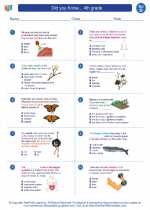Structural Adaptations
Structural adaptations are physical features of an organism's body that help it to survive and thrive in its environment. These adaptations can include various body parts, such as beaks, wings, claws, fur, and camouflage. They are the result of the process of natural selection, where organisms with beneficial traits are more likely to survive and reproduce, passing on those traits to future generations.
Examples of Structural Adaptations
- Camouflage: Many animals have evolved colors and patterns that help them blend into their surroundings, making them less visible to predators or prey.
- Beak shapes: Birds have developed a variety of beak shapes suited to their diets, such as long, thin beaks for probing flowers for nectar or stout, hooked beaks for tearing flesh.
- Claws and teeth: Predatory animals often have sharp claws and teeth for catching and consuming prey.
- Fur and feathers: Insulating fur and feathers help animals regulate their body temperature and protect them from the elements.
- Webbed feet: Aquatic animals like ducks and frogs have webbed feet for efficient swimming.
Study Guide for Structural Adaptations
- What are structural adaptations?
- How do structural adaptations help organisms survive?
- Give three examples of structural adaptations and explain how each helps the organism.
- Explain the process of natural selection and how it relates to structural adaptations.
- Choose an animal and research its structural adaptations. Create a short presentation or poster highlighting its adaptations and how they benefit the animal.
◂Science Worksheets and Study Guides Fourth Grade. Did you Know... 4th grade
Study Guide Did you Know... 4th grade
Did you Know... 4th grade  Worksheet/Answer key
Worksheet/Answer key Did you Know... 4th grade
Did you Know... 4th grade  Worksheet/Answer key
Worksheet/Answer key Did you Know... 4th grade
Did you Know... 4th grade  Worksheet/Answer key
Worksheet/Answer key Did you Know... 4th grade
Did you Know... 4th grade 

 Worksheet/Answer key
Worksheet/Answer key
 Worksheet/Answer key
Worksheet/Answer key
 Worksheet/Answer key
Worksheet/Answer key

The resources above cover the following skills:
Core Ideas for Knowing Science
Life Science
Organisms are organized on a cellular basis and have a finite life span.